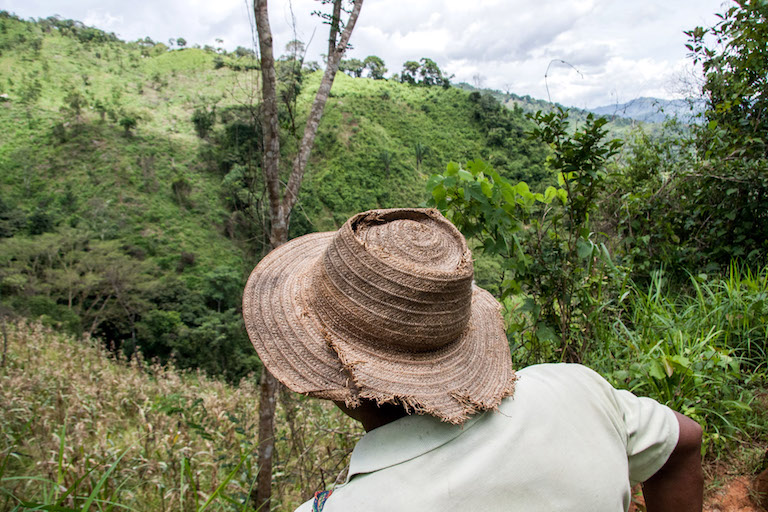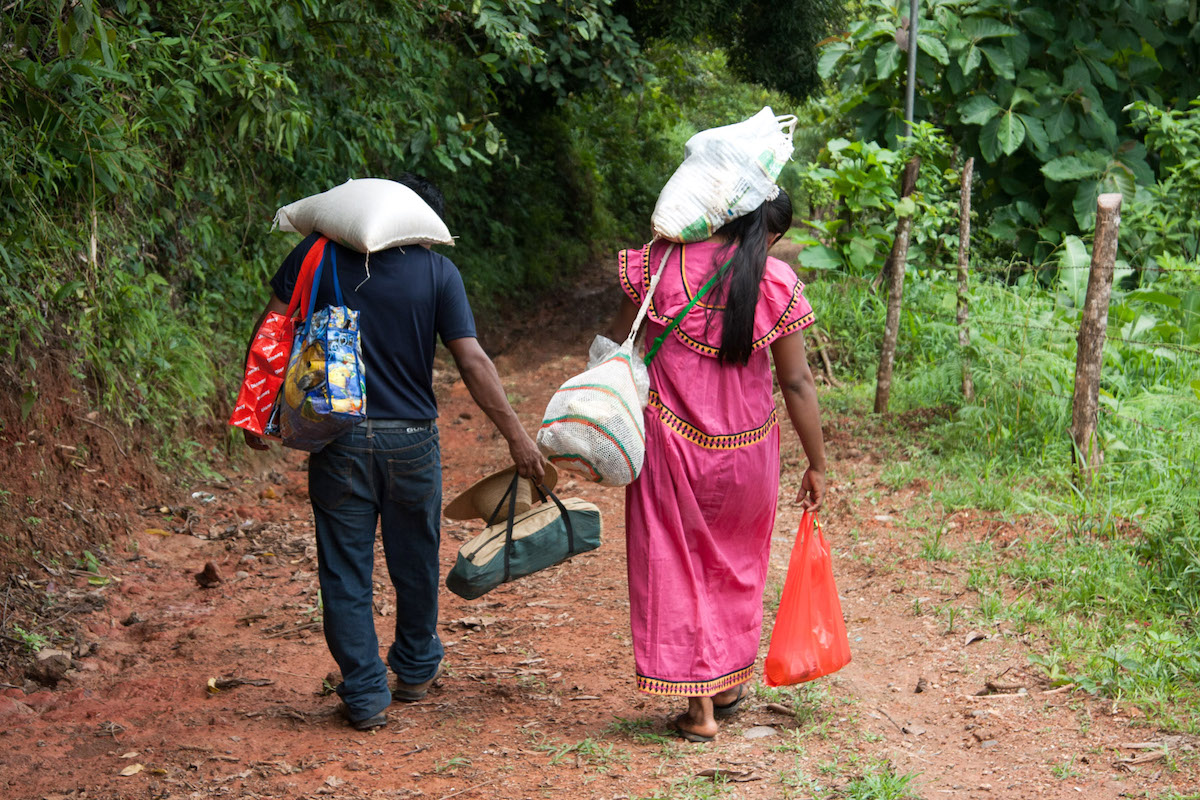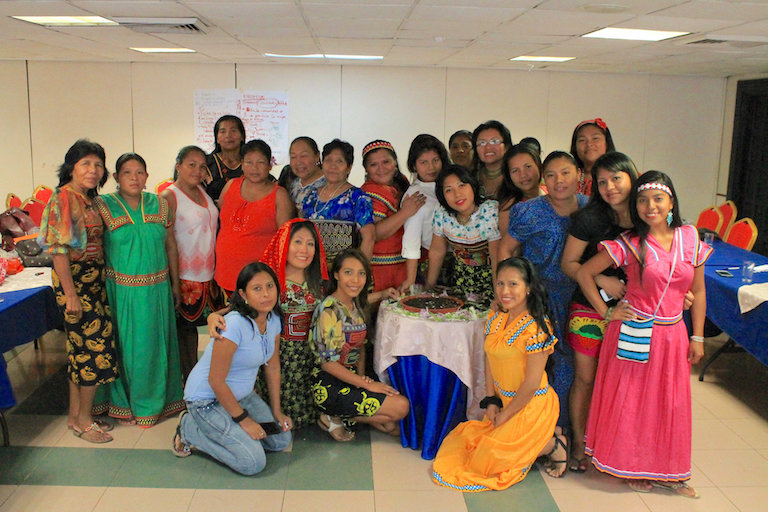- Malnutrition rates of indigenous children in Panama’s rural areas can be three to five times higher than that of non-indigenous children in the cities.
- Poor access to employment and health care, a lack of participation in politics, land conflicts over resource development projects, and farming problems related to volatile climactic conditions all contribute to food insecurity among Panama’s indigenous groups.
- Now, a 10-month program for indigenous women headed by the International Indigenous Women’s Forum aims to tackle food security among indigenous groups in Panama, as well as in Paraguay and El Salvador.
Emerita Sánchez, a member of the Naso indigenous group in northwestern Panama, had never really thought about the dietary changes her community has made over the past few decades. That changed when she attended a recent UN-backed food security workshop aimed at indigenous women. Now Sánchez notices that her community has turned away from its land and people are simply buying their food rather than growing it.
“The way of life of our community is fading, and we’re not seeing the importance and the value of the food that we used to consume, organic and without chemicals,” Sanchez, age 32, told Mongabay. For her, it is practices like these that are leading to food insecurity for indigenous Panamanians.
Although Panama has made positive strides in reducing poverty and malnutrition over the past few years, rates among indigenous people remain some of the highest in Central America. According to the Food and Agriculture Organization of the United Nations (FAO), malnutrition rates of indigenous children in Panama’s rural areas can be three to five times higher than that of non-indigenous children in the cities. Last year the FAO confirmed that 19 percent of indigenous children in Panama suffer chronic malnutrition.

Now, an ongoing program headed by the International Indigenous Women’s Forum (FIMI) and supported by the FAO aims to tackle food security issues experienced by Panama’s indigenous population.
The first workshop of FIMI’s Human Rights, Food Security and Nutrition Program took place in Panama City from August 8 through 12. It brought together 26 women, including Sánchez, from different ethnic groups to strengthen their knowledge of food security, leadership, and legal mechanisms relating to indigenous and human rights. The 10-month program aims to equip participants to take on leadership roles and develop individual projects to tackle pertinent issues within their communities. The program will also be held with indigenous women in Paraguay and El Salvador.

According to Teresa Zapeta, FIMI’s Program Coordinator, the five-day workshop in Panama gave the participating women a chance to express their concerns about food security and other issues affecting their respective communities, including mining projects, environmental degradation, and climate change.
“Food security has many aspects, such as the quality of food that can be accessed by communities, which is heavily affected by the contamination of their surrounding environment,” she told Mongabay. “The [participants] also highlighted changing weather patterns, how the seasons are not as defined anymore and how this is affecting their crops and fishing, which impacts their entire family.”
Food security is not just about being able to grow crops, she added, but also about the lack of opportunities that many indigenous communities face. These include poor access to employment and health care and a lack of participation in politics and other decision-making processes.

Effects of this insecurity are compounded by the fact that Panama also has the highest economic inequality between indigenous and non-indigenous people in Central America. According to UN figures relayed in a 2014 FAO report, Panama’s incidence of extreme poverty is 5.9 times higher among indigenous people than among non-indigenous people. This is roughly double the difference in Guatemala, where the incidence of extreme poverty among indigenous people is 2.8 times higher than among non-indigenous people, and far above Nicaragua (2.3 times) and Honduras (1.8 times).
Land conflicts perpetuated by resource development projects and crop issues resulting from a highly volatile climate add to the uncertainty for many indigenous people, who traditionally rely on their immediate environment.
The indigenous community of Kiad in the Ngäbe-Buglé semi-autonomous region in western Panama is facing food security challenges caused by this very combination of factors.
Located on the Tabasará river, Kiad is three miles upstream of the Barro Blanco dam. The controversial hydroelectric project is structurally complete but has yet to enter full operation due to nine years of community opposition. An agreement to bring the dam online signed in August by the Panamanian government and indigenous authorities recently collapsed.
According to Kiad resident Goejet Miranda, a part of the dam’s 258-hectare reservoir will flood the community’s most fertile riverside land, directly curtailing more than 60 percent of their food production. Furthermore, he added, the “test” flooding of the reservoir that began in May this year has already visibly harmed the river’s fish and the ecosystem as a whole.

“We have not fished in the river for over four months. A month after they closed the gates to fill the reservoir we saw thousands of dead fish on the river, rotting. They were all swimming upstream and just dying,” he told Mongabay.
The loss of the fertile land means that the community will have to make greater use of the nearby mountainous areas to plant their staple crops of plantains, corn, and rice. But these areas have a more acidic soil that tends to produce lower yields, Miranda said.

When asked about the climate’s effect on his community’s crops, Miranda pointed to a sharp drop in harvest figures over the past 10 years as evidence of a strong link between the two.
“Ten years ago, for example, we used to plant 50 pounds of rice to harvest at least 10,000 to 12,000 pounds of rice. Now we plant 30 to 40 pounds and harvest about 1,000 pounds. It rains less, the climate itself produces a lot of disease for the plants and it doesn’t allow them to produce,” Miranda said.
Barro Blanco’s test flooding, which was paused briefly in June this year due to widespread protests and strong national criticism, restarted in late August and has flooded much of the riverside land used by Kiad and two other communities.

However, food insecurity among indigenous Panamanians is also caused by less obvious influences, such as subtle dietary and social changes spurred by the communities’ interaction with the rest of society.
FIMI program participant Sánchez highlighted how the government’s economic aid to her community, although helpful, has meant that many people “just wait for the payments” rather than spend time working the land.
“We already have the resources to maintain our food and our diet, but we have to continue planting everything ourselves, so there is food for everyone, not just for one person or family,” said Sánchez. Although Sánchez does not want to completely reverse the changes that her community has undergone, she plans on passing on the training she received at the FIMI workshop “to bring back the importance of the land” to her community.

For FIMI’s Zapeta, the program’s focus on women strengthens indigenous communities’ ability to become more resilient, move sustainable food security projects forward, and carry on important customs that ensure adequate nutrition.
She said that indigenous women are particularly important because of their key role in maintaining food and economic security. “Many of them are carriers of medicinal and edible plant knowledge, crop production, knowledge important to the community that is not always recognized.”
Now in its second year, the current FIMI and FAO program in Panama runs until February and consists of two face-to-face workshops complemented by online material. At the culmination of the program the women will present individual food security projects they’ve developed.
“The majority of indigenous communities [around the world] are found at high levels of poverty … but just because they live in poor conditions doesn’t mean that nothing can be done,” Zapata added.
Citations
- Organización de las Naciones Unidas para la Alimentación y la Agricultura (2014). PANORAMA de la Seguridad Alimentaria y Nutricional 2014 en Centroamérica y República Dominicana, Ciudád de Panama: Panama.
